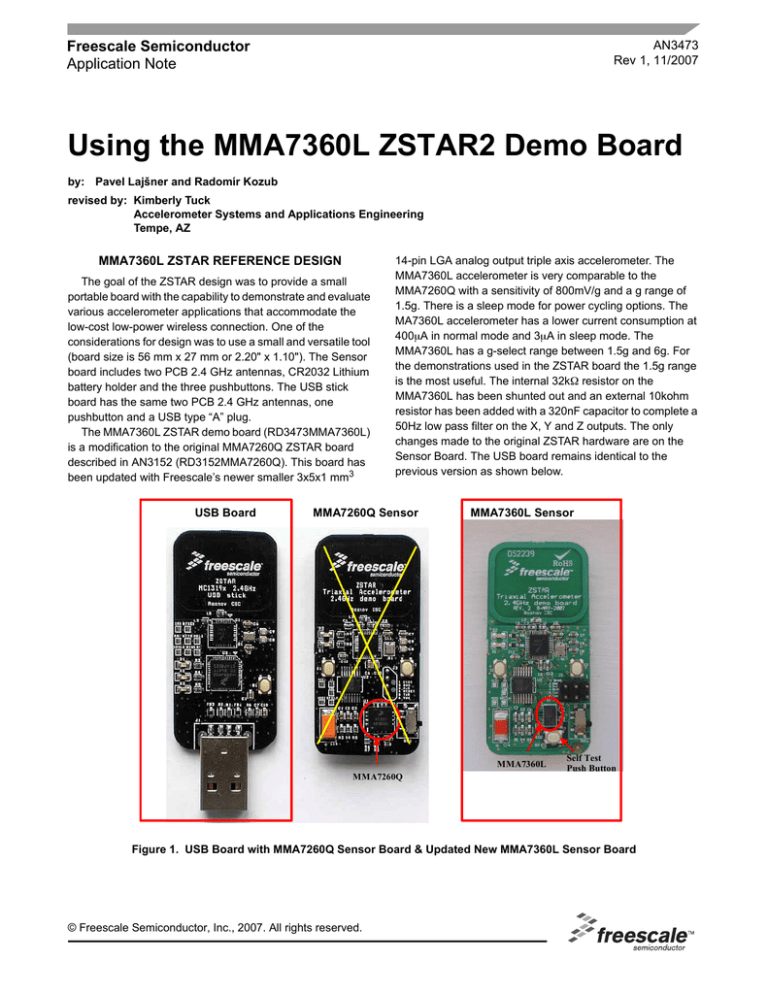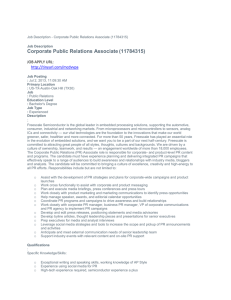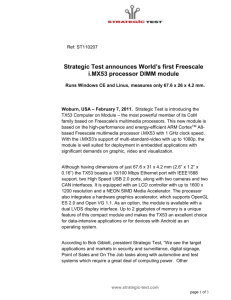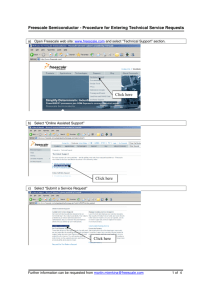
AN3473
Rev 1, 11/2007
Freescale Semiconductor
Application Note
Using the MMA7360L ZSTAR2 Demo Board
by: Pavel Lajšner and Radomír Kozub
revised by: Kimberly Tuck
Accelerometer Systems and Applications Engineering
Tempe, AZ
MMA7360L ZSTAR REFERENCE DESIGN
The goal of the ZSTAR design was to provide a small
portable board with the capability to demonstrate and evaluate
various accelerometer applications that accommodate the
low-cost low-power wireless connection. One of the
considerations for design was to use a small and versatile tool
(board size is 56 mm x 27 mm or 2.20" x 1.10"). The Sensor
board includes two PCB 2.4 GHz antennas, CR2032 Lithium
battery holder and the three pushbuttons. The USB stick
board has the same two PCB 2.4 GHz antennas, one
pushbutton and a USB type “A” plug.
The MMA7360L ZSTAR demo board (RD3473MMA7360L)
is a modification to the original MMA7260Q ZSTAR board
described in AN3152 (RD3152MMA7260Q). This board has
been updated with Freescale’s newer smaller 3x5x1 mm3
USB Board
14-pin LGA analog output triple axis accelerometer. The
MMA7360L accelerometer is very comparable to the
MMA7260Q with a sensitivity of 800mV/g and a g range of
1.5g. There is a sleep mode for power cycling options. The
MA7360L accelerometer has a lower current consumption at
400μA in normal mode and 3μA in sleep mode. The
MMA7360L has a g-select range between 1.5g and 6g. For
the demonstrations used in the ZSTAR board the 1.5g range
is the most useful. The internal 32kΩ resistor on the
MMA7360L has been shunted out and an external 10kohm
resistor has been added with a 320nF capacitor to complete a
50Hz low pass filter on the X, Y and Z outputs. The only
changes made to the original ZSTAR hardware are on the
Sensor Board. The USB board remains identical to the
previous version as shown below.
MMA7260Q Sensor
MMA7360L Sensor
MMA7360L
MMA7260Q
Self Test
Push Button
Figure 1. USB Board with MMA7260Q Sensor Board & Updated New MMA7360L Sensor Board
© Freescale Semiconductor, Inc., 2007. All rights reserved.
Hardware Changes for the MMA7360L ZSTAR
Sensor Board
As shown in Figure 1, a push button and a populated 6-pin
header has been added to the sensor board along with the
MMA7360 14 pin LGA packaged accelerometer which
replaces the 16-pin QFN package accelerometer. The 6-pin
header has been added to this board to make it easier to
update the firmware when changes occur. The connections
between the MMA7360L accelerometer and the
MC9SO8QG8 microcontroller are shown in Figure 2 of the
Sensor Board Schematic. The new accelerometer has only
1 g-select pin (pin10) which is connected to PTB1 on the
microcontroller. The g-select by default is in 1.5g mode, and
therefore set to 0. The 0g detect internal logic pin (pin 9) on
the MMA7360L is connected to PTB0 on the microcontroller.
The self test pin (pin 13) on the MMA7360L is connected to a
pushbutton so that the self test function can be activated when
the push button is held down. The Z output should increase by
1g when the push button is pressed. The self test function
validates the correct operation of the g-cell.
PC GUI Updates for the MMA7360L ZSTAR
The Triax GUI PC-software for this demonstration has been
updated using Visual Studio C# Express 2005 Edition along
with a tool box from National Instruments to implement some
of the graphing tools and gauges. Many of the algorithms have
been improved along with some additional applications.
These improved demonstrations are designed to allow
visualization of key accelerometer applications in the
consumer industry as well as the low-cost 2.4 GHz wireless
solution based on the MC13191 transceiver. For information
and detailed guidance on using the updated Triax Software
please refer to the Triax Reloaded 1.0 User Manual. Details
about the algorithms used in the software can be found in
various application notes and also on the “about” screens in
the software.
FEATURED FREESCALE PRODUCTS
The ZSTAR is a two-board design where a MMA7360L
triple axis accelerometer is controlled by an 8-bit MCU
MC9S08QG8 and connected via a wireless link to a computer.
The USB stick connects via the computer’s USB slot. For the
USB communication, a Full-Speed USB 2.0 8-bit
microcontroller MCHC908JW32 is employed. The various
Freescale products in this demonstration are detailed below.
Triple Axis Accelerometer MMA7360L
The ZSTAR board is a demonstration tool for the
MMA7360L, a 3-Axis Low-g accelerometer. The MMA7360L
has many unique features that make it an ideal solution for
many consumer applications such as freefall protection for
laptops and MP3 players, tilt detection for e-compass
compensation and cell phone scrolling, motion detection for
handheld games and game controllers, position sensing for
g-mice, shock detection for warranty monitors, and vibration
for out of balance detection.
Features such as low power, low current, and sleep mode
with a quick turn-on time allow the battery life to be extended
in end applications. The 3-axis sensing in a small LGA
package requires only 3 mm x 5 mm board space, with a
profile of 1 mm, allowing for easy integration into many small
handheld electronics.
There are several other derivatives of MMA7360L:
MMA7340L 3g/12g, MMA7330L 4g/16g.
All members of this sensor family are footprint (LGA
package) compatible, which simplifies the evaluation and
design of the target application.
Microcontroller MC9S08QG8
The MC9S08QG8 is a highly integrated member of
Freescale’s 8-bit family of microcontrollers based on the highperformance, low-power consumption HCS08 core.
Integrating features normally found in larger, more expensive
components, the MC9S08QG8 MCU includes a background
debugging system and on-chip in-circuit emulation (ICE)
with real-time bus capture, providing single-wire debugging
and emulation interface. It also features a programmable 16bit timer/pulse-width modulation (PWM) module (TPM) that is
one of the most flexible and cost-effective of its kind.
The compact, tightly integrated MC9S08QG8 delivers a
versatile combination and wealth of Freescale peripherals and
the advanced features of the HCS08 core, including extended
battery life with maximum performance down to 1.8 V,
industry-leading Flash and innovative development support.
The MC9S08QG8 is an excellent solution for power and sizesensitive applications, such as wireless communications and
handheld devices, small appliances, Simple Media Access
Controller (SMAC)-based applications and toys.
MC13191 2.4 GHz ISM Band Low Power Transceiver
The MC13191 is a short range, low power, 2.4 GHz
Industrial, Scientific, and Medical (ISM) band transceiver. The
MC13191 contains a complete packet data modem which is
compliant with the IEEE® 802.15.4 Standard PHY (Physical)
layer. This allows the development of proprietary point-topoint and star networks based on the 802.15.4 packet
structure and modulation format. For full 802.15.4 compliance,
the MC13192 and Freescale's 802.15.4 MAC software are
required.
When combined with an appropriate microcontroller
(MCU), the MC13191 provides a cost-effective solution for
short-range data links and networks. Interfacing the MCU is
accomplished by using a four wire serial peripheral interface
(SPI) connection and an interrupt request output which allows
for the use of a variety of processors. The software and
processor can be scaled to fit applications ranging from simple
point-to-point to star networks.
AN3473
2
Sensors
Freescale Semiconductor
MC13192/MC13193 2.4 GHz Low Power Transceiver
for the IEEE® 802.15.4 Standard
The MC13192 and MC13193 are short range, low power,
2.4 GHz Industrial, Scientific, and Medical (ISM) band
transceivers. The MC13192/MC13193 contains a complete
802.15.4 physical layer (PHY) modem designed for the IEEE®
802.15.4 wireless standard which supports peer-to-peer, star,
and mesh networking.
The MC13192 includes the 802.15.4 PHY/MAC for use with
the HCS08 Family of MCUs. The MC13193 also includes the
802.15.4 PHY/MAC plus the ZigBee© Protocol Stack for use
with the HCS08 Family of MCUs. With the exception of the
addition of the ZigBee© Protocol Stack, the MC13193
functionality is the same as the MC13192.
When combined with an appropriate microcontroller
(MCU), the MC13192/MC13193 provides a cost-effective
solution for short-range data links and networks. Interfacing
the MCU is accomplished by using a four wire serial peripheral
interface (SPI) connection and an interrupt request output
which allows for the use of a variety of processors. The
software and processor can be scaled to fit applications
ranging from simple point-to-point systems, through complete
ZigBee© networking.
Microcontroller MCHC908JW32
The MCHC908JW32 is a member of the low-cost, highperformance M68HC08 Family of 8-bit microcontroller units
(MCUs). All MCUs in the family use the enhanced M68HC08
central processor unit (CPU08) and are available with a
variety of modules, memory sizes and types, and package
types.
FIRMWARE
This reference design contains two pieces of firmware. The
first one is on the Sensor board MCU (MC9S08QG8). Its job
is to collect sensor data from the MMA7360L accelerometer,
create a data packet and send it over the SMAC (Simple
Media Access Controller) driver using the MC13191 RF
Transceiver.
The sensor data is measured over three channels of the
Analog-to-Digital converter, while another GPIO pin controls
the sleep mode of the MMA7360L accelerometer to conserve
power.
Serial Peripheral Interface (SPI) is used for communication
with the MC13191.
The overall application is powered from the coin-sized
CR2032 Lithium battery that is located on the bottom side of
the board. The overall average current consumption is below
1 mA with 20 data transmissions per second rate. This allows
approximately 10 days of continuous operation at this realtime data rate.
The simple ZSTAR RF protocol also transfers the
calibration data. These data are stored in non-volatile Flash
memory and are transferred on request.
The second piece of firmware is contained within the USB
stick board and its job is to create a “bridge” between the RF
link and the USB connection. The sensor and keyboard data
are received from the Sensor board and stored in the USB
stick RAM memory. Another independent process is the USB
protocol communication. Several options are possible. USB
specifications define several ways of transferring data
between the USB peripheral and the PC (called “profiles” or
classes). In this demo two classes are demonstrated:
The Microsoft™ Windows 2000/XP operating system
contains by default a driver support for these classes which
makes this solution simple for demonstration purposes.
If the serial communication (virtual serial port) is
demonstrated, the accelerometric data is available through
the simple serial protocol compatible with the STAR demo.
Thus most of the RD3473MMA7360L is usable also for data
visualization.
Alternatively, if the HID class is demonstrated, the ZSTAR
demo behaves as a mouse. By tilting the sensor board, the
mouse cursor movement can be controlled.
SUMMARY
Multi-axis sensing using an XYZ-axis low g acceleration
sensor, MMA7360L with selectable g-ranges of 1.5g/6g, is
combined with the versatile MC9S08QG8 8-bit
microcontroller. The 2.4 GHz wireless communication is
enabled by RFCMOS technology. The MC13191 is a member
of the pin-to-pin compatible series of Freescale's transceivers,
including the MC13192 which supports the IEEE 802.15.4
protocol and the MC13193 which supports full ZigBee©
compliant applications. Please refer to AN3152 for the
complete details of the original design of the ZSTAR
RD3152MMA7260Q.
AN3473
Sensors
Freescale Semiconductor
3
Figure 2. Schematic MMA7360L Sensor Board
AN3473
4
Sensors
Freescale Semiconductor
Figure 3. Schematic of the USB Board
AN3473
Sensors
Freescale Semiconductor
5
How to Reach Us:
Home Page:
www.freescale.com
Web Support:
http://www.freescale.com/support
USA/Europe or Locations Not Listed:
Freescale Semiconductor, Inc.
Technical Information Center, EL516
2100 East Elliot Road
Tempe, Arizona 85284
+1-800-521-6274 or +1-480-768-2130
www.freescale.com/support
Europe, Middle East, and Africa:
Freescale Halbleiter Deutschland GmbH
Technical Information Center
Schatzbogen 7
81829 Muenchen, Germany
+44 1296 380 456 (English)
+46 8 52200080 (English)
+49 89 92103 559 (German)
+33 1 69 35 48 48 (French)
www.freescale.com/support
Japan:
Freescale Semiconductor Japan Ltd.
Headquarters
ARCO Tower 15F
1-8-1, Shimo-Meguro, Meguro-ku,
Tokyo 153-0064
Japan
0120 191014 or +81 3 5437 9125
support.japan@freescale.com
Asia/Pacific:
Freescale Semiconductor Hong Kong Ltd.
Technical Information Center
2 Dai King Street
Tai Po Industrial Estate
Tai Po, N.T., Hong Kong
+800 2666 8080
support.asia@freescale.com
For Literature Requests Only:
Freescale Semiconductor Literature Distribution Center
P.O. Box 5405
Denver, Colorado 80217
1-800-441-2447 or 303-675-2140
Fax: 303-675-2150
LDCForFreescaleSemiconductor@hibbertgroup.com
AN3473
Rev. 10
11/2007
Information in this document is provided solely to enable system and software
implementers to use Freescale Semiconductor products. There are no express or
implied copyright licenses granted hereunder to design or fabricate any integrated
circuits or integrated circuits based on the information in this document.
Freescale Semiconductor reserves the right to make changes without further notice to
any products herein. Freescale Semiconductor makes no warranty, representation or
guarantee regarding the suitability of its products for any particular purpose, nor does
Freescale Semiconductor assume any liability arising out of the application or use of any
product or circuit, and specifically disclaims any and all liability, including without
limitation consequential or incidental damages. “Typical” parameters that may be
provided in Freescale Semiconductor data sheets and/or specifications can and do vary
in different applications and actual performance may vary over time. All operating
parameters, including “Typicals”, must be validated for each customer application by
customer’s technical experts. Freescale Semiconductor does not convey any license
under its patent rights nor the rights of others. Freescale Semiconductor products are
not designed, intended, or authorized for use as components in systems intended for
surgical implant into the body, or other applications intended to support or sustain life,
or for any other application in which the failure of the Freescale Semiconductor product
could create a situation where personal injury or death may occur. Should Buyer
purchase or use Freescale Semiconductor products for any such unintended or
unauthorized application, Buyer shall indemnify and hold Freescale Semiconductor and
its officers, employees, subsidiaries, affiliates, and distributors harmless against all
claims, costs, damages, and expenses, and reasonable attorney fees arising out of,
directly or indirectly, any claim of personal injury or death associated with such
unintended or unauthorized use, even if such claim alleges that Freescale
Semiconductor was negligent regarding the design or manufacture of the part.
Freescale™ and the Freescale logo are trademarks of Freescale Semiconductor, Inc.
All other product or service names are the property of their respective owners.
© Freescale Semiconductor, Inc. 2007. All rights reserved.






